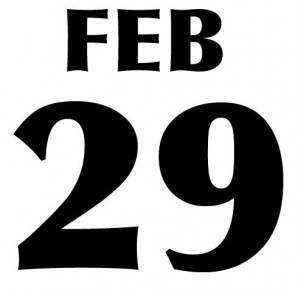 A leap year (or intercalary or bissextile year) is a year containing one additional day in order to keep the calendar year synchronized with the astronomical or seasonal year. Because seasons and astronomical events do not repeat in a whole number of days, a calendar that had the same number of days in each year would, over time, drift with respect to the event it was supposed to track. By occasionally inserting (or intercalating) an additional day into the year, the drift can be corrected. A year that is not a leap year is called a common year.
A leap year (or intercalary or bissextile year) is a year containing one additional day in order to keep the calendar year synchronized with the astronomical or seasonal year. Because seasons and astronomical events do not repeat in a whole number of days, a calendar that had the same number of days in each year would, over time, drift with respect to the event it was supposed to track. By occasionally inserting (or intercalating) an additional day into the year, the drift can be corrected. A year that is not a leap year is called a common year.For example, in the Gregorian calendar (a common solar calendar), February in a leap year has 29 days instead of the usual 28, so the year lasts 366 days instead of the usual 365.
In the Gregorian calendar, the current standard calendar in most of the world, most years that are evenly divisible by 4 are leap years. In each leap year, the month of February has 29 days instead of 28. Adding an extra day to the calendar every four years compensates for the fact that a period of 365 days is shorter than a solar year by almost 6 hours.
 Some exceptions to this rule are required since the duration of a solar year is slightly less than 365.25 days. Years that are evenly divisible by 100 are not leap years, unless they are also evenly divisible by 400, in which case they are leap years. For example, 1600 and 2000 were leap years, but 1700, 1800 and 1900 were not. Similarly, 2100, 2200, 2300, 2500, 2600, 2700, 2900 and 3000 will not be leap years, but 2400 and 2800 will be. Therefore, in a duration of two millennia, there will be 485 leap years. By this rule, the average number of days per year will be 365 + 1/4 − 1/100 + 1/400 = 365.2425, which is 365 days, 5 hours, 49 minutes, and 12 seconds. The Gregorian calendar was designed to keep the vernal equinox on or close to March 21, so that the date of Easter (celebrated on the Sunday after the 14th day of the Moon—i.e. a full moon—that falls on or after March 21) remains correct with respect to the vernal equinox. The vernal equinox year is about 365.242374 days long (and increasing).
Some exceptions to this rule are required since the duration of a solar year is slightly less than 365.25 days. Years that are evenly divisible by 100 are not leap years, unless they are also evenly divisible by 400, in which case they are leap years. For example, 1600 and 2000 were leap years, but 1700, 1800 and 1900 were not. Similarly, 2100, 2200, 2300, 2500, 2600, 2700, 2900 and 3000 will not be leap years, but 2400 and 2800 will be. Therefore, in a duration of two millennia, there will be 485 leap years. By this rule, the average number of days per year will be 365 + 1/4 − 1/100 + 1/400 = 365.2425, which is 365 days, 5 hours, 49 minutes, and 12 seconds. The Gregorian calendar was designed to keep the vernal equinox on or close to March 21, so that the date of Easter (celebrated on the Sunday after the 14th day of the Moon—i.e. a full moon—that falls on or after March 21) remains correct with respect to the vernal equinox. The vernal equinox year is about 365.242374 days long (and increasing). The marginal difference of 0.000125 days between the Gregorian calendar average year and the actual year means that, in 8,000 years, the calendar will be about one day behind where it is now. But in 8,000 years, the length of the vernal equinox year will have changed by an amount that cannot be accurately predicted. Therefore, the current Gregorian calendar suffices for practical purposes, and the correction suggested by John Herschel of making 4000 a non-leap year will probably not be necessary.
The marginal difference of 0.000125 days between the Gregorian calendar average year and the actual year means that, in 8,000 years, the calendar will be about one day behind where it is now. But in 8,000 years, the length of the vernal equinox year will have changed by an amount that cannot be accurately predicted. Therefore, the current Gregorian calendar suffices for practical purposes, and the correction suggested by John Herschel of making 4000 a non-leap year will probably not be necessary.


1 comentários:
Write comentáriosHello staff and students from Fisk PG. I´m really happy to have a place on net to get in contact with you. I taught there some years ago and I still miss you a lot. This blog is good way to enjoy again the best place I´ve ever studied and worked. Miss you a lot and congratulations!!
Reply